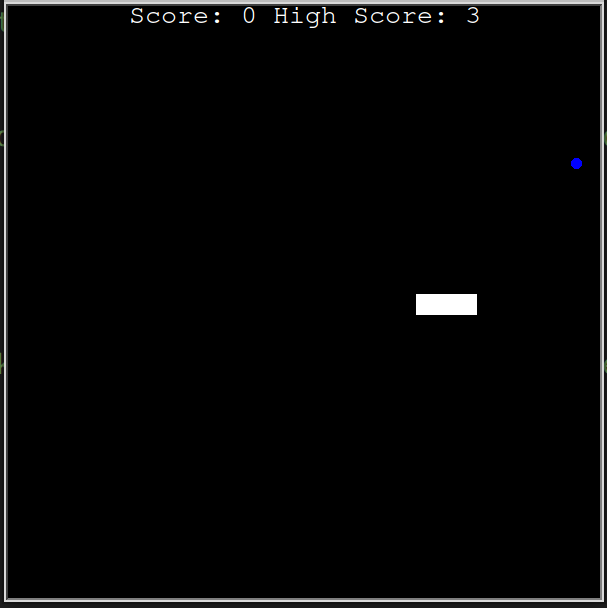This app was build using the Turtle libray.
Clone this repo or download. Once downloaded, open in any IDE of your choice.
Once opened, hit the play button (normally in the top right corner).
Use the arrow keys on your keyboard to move the snake. If you hit an apple, illustrated as a blue cicle on the screen, the snake will grow by one square. Once the snake hits itself or the wall, you will respawn in the 0,0 position, right in the middle of the screen.
Object Oriented Programming was used for instances of the scoreboard, when the snake moves or changes, and the apple or 'food'.
To keep track of the current score, the Turtle class is extended to make use of some of the methods.
class Scoreboard(Turtle):
def __init__(self):
super().__init__()
self.score = 0
self.highscore = 0
# hides the tracer and the initial turtle shape
self.hideturtle()
self.penup()
self.color("white")
# moves to a location at the top of the screen
self.goto(0, 320)
# runs the update_score method
self.update_score()
...Updating the scoreboard using def update_score, increasing the scores counter def counter and updating the highscore def high_score were methods added to the Scoreboard class. NOTE: update_score reads from the high_score.txt file storing the previously saved high score through mode='r. high_score checks the current score for a new high score and overwrites the current addition using mode=wif this condition is met.
def update_score(self):
# writes the variables to the screen. Clear screen was added in here. This is because the game_over method is
# not being used anymore. this wasn't previously reset because the score stayed in the screen when the game
# finished.
self.clear()
with open("high_score.txt", mode="r") as h_score:
high_score = h_score.read()
self.write(f"Score: {self.score} High Score: {high_score}", True, align=ALIGNMENT, font=FONT)
def counter(self):
self.score += 1
self.goto(0, 270)
self.update_score()
def high_score(self):
# updating the high score when the current score is higher at the end of the game
if self.score > self.highscore:
with open("high_score.txt", mode="w") as h_score:
h_score.write(f"{self.score}")
# reset the game score
self.score = 0
# reset the position to the center top location. Otherwise, the score will move off screen
self.goto(0, 270)
# start the score_update() method all over again
self.update_score()The Snake class defines the methods used for movememnt and all other physical characterisitics. For example, the def grow() method will take the current position of the last block in the snake, instatinate a new block and then add it to the tail of the snake.
...
def grow(self):
# Storing the xy coordinates of the last positon.
last_square_x = self.square_list[len(self.square_list) - 1].xcor()
last_square_y = self.square_list[len(self.square_list) - 1].ycor()
# Instantiating a new square and calling it the tail (where we will grow the snake).
tail_square = Turtle("square")
tail_square.color("white")
tail_square.penup()
# Using the Turtle library to move the square to the stored coordinates.
tail_square.goto(last_square_x, last_square_y)
# Finally, appending the square.
self.square_list.append(tail_square)
...Food class is a representation of the apple in the game. Again, this extends the Turtle class to make use of some standard methods. This can be seen from the code snippet below:
class Food(Turtle):
def __init__(self):
super().__init__() # calling the Turtle class the super class. All attributes/methods can be used here now
self.shape("circle")
self.penup()
self.shapesize(stretch_len=0.5, stretch_wid=0.5)
self.color("blue")
self.speed("fastest")
self.new_loc()
....randint is used to place the food in a new random location once the previous one has been eaten. The new_loc method takes care of this.
...
def new_loc(self):
random_x = random.randint(-280, 280)
random_y = random.randint(-280, 280)
self.goto(random_x, random_y)Finally, in the main.py, after configuration and instantiation, we have three conditionals for collision detection. First, we check for food collision, wall collision and collision with self
...
if snake.head.distance(food) < 15:
# we are using the attribute defined as "head" (snakes head) to check if its less
# than 15 pixels away from the food. This will mean it is close enough to call it a collision. Distance is a
# method from the Turtle class
snake.grow()
# moving the food to a random location
food.new_loc()
score.counter()
if snake.head.xcor() > 280 or snake.head.xcor() < -280 or snake.head.ycor() > 280 or snake.head.ycor() < -280:
# updating the high score
score.high_score()
# resetting the position of the starting snake (three squares)
snake.reset_pos()
for squares in snake.square_list[1:]:
# this is so that if any of the squares get within 15 pixels of each other,
# its game over
if snake.head.distance(squares) < 5:
# same as above for high score
score.high_score()
snake.reset_pos()
# score.game_over()
...This game was originally developed in 2021. After revisiting in 2023, tkinter module went through an update. The development of the module moved to a new repository and required it to be installed locally in order for it to be run with this application.
